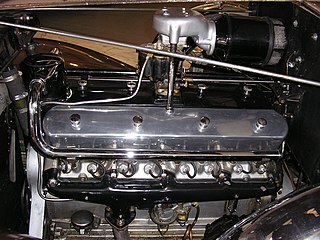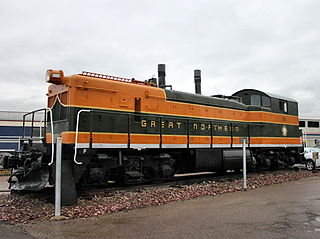Related Research Articles

A V12 engine is a twelve-cylinder piston engine where two banks of six cylinders are arranged in a V configuration around a common crankshaft. V12 engines are more common than V10 engines. However, they are less common than V8 engines.

A V16 engine is a sixteen-cylinder piston engine where two banks of eight cylinders are arranged in a V configuration around a common crankshaft. V16 engines are less common than engines with fewer cylinders, such as V8 and V12 engines. Each bank of a V16 engine can be thought of as a straight-8, a design that can be inherently balanced. Most V16 engines have a 45° bank angle.
A V20 engine is a twenty-cylinder piston engine where two banks of ten cylinders are arranged in a V configuration around a common crankshaft. Large diesel V20 engines have been used in diesel locomotives, haul trucks, electric generators and marine applications.

A diesel locomotive is a type of railway locomotive in which the power source is a diesel engine. Several types of diesel locomotives have been developed, differing mainly in the means by which mechanical power is conveyed to the driving wheels. The most common are diesel-electric locomotives and diesel-hydraulic.

The E9 is a 2,400-horsepower (1,790 kW), A1A-A1A passenger train-hauling diesel locomotive built by General Motors' Electro-Motive Division of La Grange, Illinois, between April 1954 and January 1964. 100 cab-equipped A units were produced and 44 cabless booster B units, all for service in the United States. The E9 was the tenth and last model of EMD E-unit and differed from the earlier E8 as built only by the newer engines and a different, flusher-fitting mounting for the headlight glass, the latter being the only visible difference. Since some E8s were fitted with this, it is not a reliable way to distinguish the two. The E9 has two 1,200 hp (895 kW), V12 model 567C engines, each engine driving one generator to power two traction motors.

The Union Pacific Railroad's M-10001 was a diesel-electric streamlined train built in 1934 by Pullman-Standard with a power system developed by General Motors Electro-Motive Corporation using a Winton 201A Diesel engine and General Electric generator, control equipment and traction motors. It was the UP's second streamliner after the M-10000, their first equipped with a diesel engine and was a longer train than its three-car predecessor. All cars were articulated—trucks were shared between each car. It was delivered on October 2, 1934, and was used for display, test and record-setting runs for the next two months before being returned to Pullman-Standard for an increase in power and capacity, following which it was placed into service as the City of Portland train. It has been nicknamed "The Banana".

The Union Pacific Railroad's M-10002 was a diesel-electric streamliner train built in 1936 by Pullman-Standard, with prime movers from the Winton Engine division of General Motors Corporation and General Electric generator, control equipment and traction motors. It was the UP's third streamliner, and the last turret-cab streamliner.

The EMD NW3 was a 1,000 hp (750 kW) road switcher diesel-electric locomotive built by General Motors Electro-Motive Division of La Grange, Illinois between November 1939 and March 1942. A total of seven were built for the Great Northern Railway, the sole original purchaser; they were originally numbered #5400-5406 and later renumbered #175-181.

The EMD MP15, sometimes referenced as MP15DC, is a 1,500 hp (1,119 kW) diesel–electric switcher locomotive model produced by General Motors' Electro-Motive Division between 1974 and 1980. It was equipped with a V12 12-645E engine sporting a Roots blower. The length was either 47 ft 8 in (14.53 m) or 48 ft 8 in (14.83 m) depending on the build date.

Electro-Motive Diesel is a brand of diesel-electric locomotives, locomotive products and diesel engines for the rail industry. Formerly a division of General Motors, EMD is now owned by Progress Rail, a subsidiary of Caterpillar Inc. Electro-Motive Diesel traces its roots to the Electro-Motive Engineering Corporation, founded in 1922 and purchased by General Motors in 1930. After purchase by GM, the company was known as GM's Electro-Motive Division. In 2005, GM sold EMD to Greenbriar Equity Group and Berkshire Partners, and in 2010, EMD was sold to Progress Rail. Upon the 2005 sale, the company was renamed to Electro-Motive Diesel.

In rail transport, head-end power (HEP), also known as electric train supply (ETS), is the electrical power distribution system on a passenger train. The power source, usually a locomotive at the front or 'head' of a train, provides the electricity used for heating, lighting, electrical and other 'hotel' needs. The maritime equivalent is hotel electric power. A successful attempt by the London, Brighton and South Coast Railway in October 1881 to light the passenger cars on the London to Brighton route heralded the beginning of using electricity to light trains in the world.

CJSC Transmashholding is the largest manufacturer of locomotives and rail equipment in Russia and after merging with LocoTech service the fourth largest engineering company in the field of transport technology globally.

The Brookville BL20GH is a diesel-electric locomotive built by the Brookville Equipment Corporation. The locomotive is designed for both freight and passenger service. Brookville built 12 in 2008 for the Metro-North Railroad. The Staten Island Railway operates four nearly identical BL20G locomotives, built by Brookville in December 2008, in work service.
The Paxman Ventura is an internal combustion diesel engine for railway locomotives, built by Davey, Paxman & Co.
Iran Heavy Diesel Manufacturing Company(DESA), is an Iranian company which is a manufacturer of heavy diesel engines from 200 to 3500 kW for railway, marine and power generation purposes.

The Kolomna Locomotive Works is a major producer of railway locomotives as well as locomotive and marine diesel engines in Russia. The plant started production in 1869 with a freight steam locomotive, one of the first in Russia. In the Russian Empire, Kolomna was one of the few producers in Russia. During this period, 139 types of steam locomotives were designed. As of 2015, the company is now a part of Transmashholding.

The TE2 is a class of Soviet diesel-electric locomotives built by Malyshev Factory in Kharkiv, Ukraine, from 1948 to 1955. It is nominally a two-unit version of class TE1 but is very different in appearance. While the TE1 is a Co-Co hood unit, the TE2 is a Bo-Bo+Bo-Bo cab unit.
Ural Diesel Engine Plant is a company based in Yekaterinburg, Russia.

T478.3 is a class of locomotives built for Czechoslovak State Railways to replace the most powerful steam locomotives in heavy passenger and freight service. Their design is based on the type T478.1; the main difference is the new, more powerful V12 diesel engine.

TEM1 was a Soviet diesel-electric locomotive, produced between 1958 and 1968 at the Bryansk Machinery Plant (BMZ).
References
- 1 2 3 4 5 "Бухгалтерская отчётность" . Retrieved 28 October 2018.
- ↑ "Penza diesel". Archived from the original on 2019-01-12. Retrieved 2015-08-22.
- ↑ sdelanounas.ru/blogs/60633/